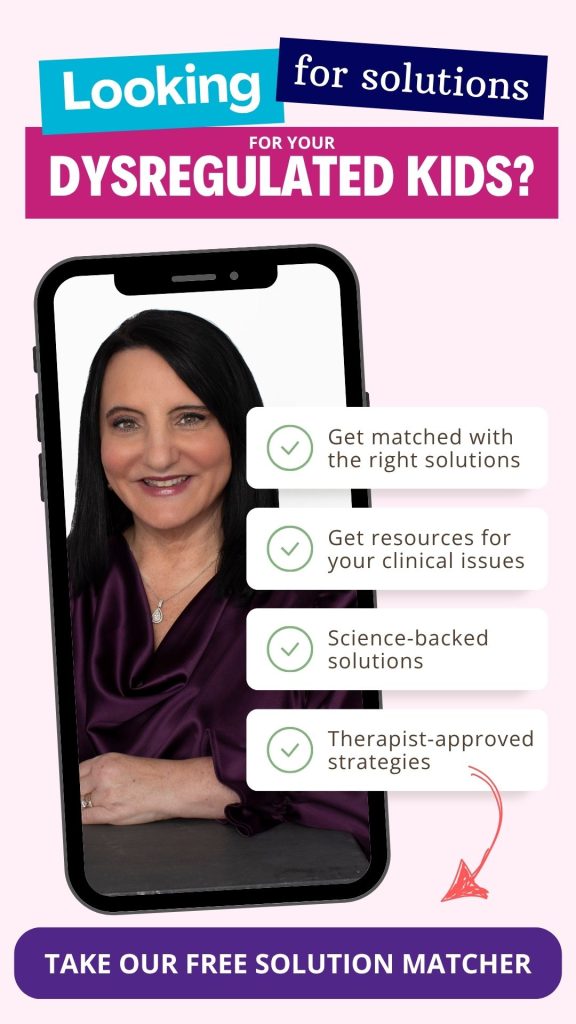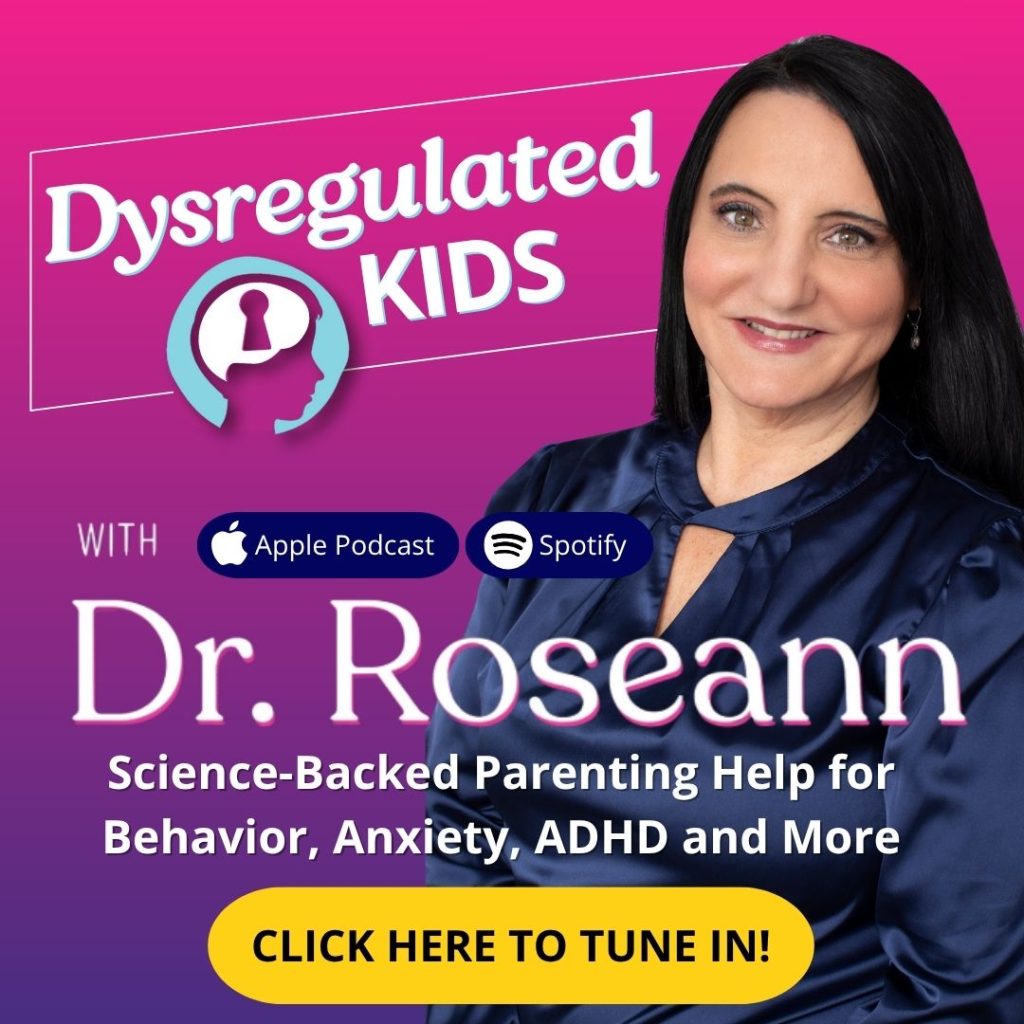Estimated reading time: 8 minutes
When your child’s behavior feels completely out of control, you’re probably left wondering—What’s going on with my child? Why are they reacting this way?
Parents of children with ADHD, anxiety, OCD, ASD, or PANS/PANDAS often face emotional and behavioral extremes that can feel impossible to manage. You’re not alone in this. Understanding dysregulation and the science behind it is the first step toward making real, lasting change.
In this post, we’ll explore how dysregulation episodes progress with age, why they change, and, most importantly, how you can help your child regain control. By the end, you’ll have practical, science-backed strategies to manage and reduce dysregulation in your child’s life.

What Is Nervous System Dysregulation?
Nervous system dysregulation is when your child’s brain can’t return to a state of calm after stress. Instead of bouncing back, their system stays stuck in survival mode—fight, flight, or freeze.
This isn’t misbehavior. It’s not about being spoiled or dramatic. It’s a biological brain response to overwhelm. And until the nervous system feels safe, your child won’t be able to access self-control, problem-solving, or reasoning skills.
Dysregulation in children varies in presentation and prevalence across different age groups. Younger children may show more temper tantrums, while older children may have a hard time with irritability or managing frustrations. Factors like your (the parent’s) regulation, early childhood experiences, and underlying conditions like ADHD can also influence how dysregulation shows.
Why Dysregulation Shifts with Age
As children grow, their brains develop more advanced coping tools. But if those tools aren’t modeled, supported, or taught, the expression of dysregulation just changes shape.
Think of it like this:
💬 A tantrum at age 3 might turn into verbal outbursts at age 9…
💬 …then into social withdrawal or perfectionism at 14.
But why does dysregulation show up differently over time?..
Well, it’s due to a variety of contributing factors that also change as time goes by:
- Overactive or underactive nervous system: When the nervous system is overstimulated or under stimulated, it can trigger intense emotional reactions.
- Genetic and environmental factors: Family history, stress, trauma, or lack of emotional support can contribute to the development of dysregulation.
“When trauma occurs early in life, it can alter the brain’s stress-response systems, creating pathways that contribute to chronic emotional and behavioral dysregulation.” – Dr. Stephen Crowell and Dr. Theodore Beauchaine (Crowell & Beauchaine, 2017)
- Brain development: Areas of the brain that control emotions and behavior may not be fully developed, especially in younger children.
“Emotion regulation relies on the development of brain regions like the prefrontal cortex and amygdala, and early life stress can disrupt these pathways, leading to persistent dysregulation.” – Dr. Christina Deveney and Dr. Madeline Dreyfuss (Deveney & Dreyfuss, 2021)
That’s why it’s so important to recognize what dysregulation looks like at each age—and how to support the brain beneath the behavior.

What Dysregulation Looks Like at Different Ages
Here’s a breakdown of common dysregulation symptoms by age group:
| Age Group | How Dysregulation May Show Up |
|---|---|
| Toddlers | Screaming, throwing toys, lying on the floor, biting |
| Preschoolers | Defiance, hitting, refusal to follow directions |
| School-age | Meltdowns after school, talking back, aggression |
| Tweens/Teens | Isolation, angry outbursts, avoidance, perfectionism |
Each behavior is your child’s nervous system saying, “I don’t feel safe or in control right now.” When we respond with regulation instead of punishment, we teach their brain how to return to calm.
What Happens During a Dysregulation Episode?
Most dysregulation episodes follow a predictable cycle. Once you learn to recognize these stages, you’ll know when to intervene—and when to just ride the wave with support.
🌀 The 5 Phases of Dysregulation:
- Trigger
A stressor sets things off—this could be loud noise, a denied request, or even hunger. - Escalation
Your child’s body tenses. They might raise their voice, cry, lash out, or run. - Peak
This is the meltdown or shutdown phase. Full-blown yelling, hiding, or aggressive behavior may appear. - De-escalation
The storm begins to pass. Energy lowers, but they’re not back to baseline yet. - Recovery
Fatigue, withdrawal, or remorse may show up. This is a critical time for co-regulation and repair.
💡 Real-life example:
Sarah, a mom of a 9-year-old with ADHD, noticed her son’s worst episodes came after too much screen time or noisy environments. Once she started limiting stimulation and building in sensory breaks, his outbursts became shorter and less intense.
How Can I Help My Child Calm Down When They’re Dysregulated?
When your child is in a dysregulated state, it’s important to address the emotional overwhelm before addressing the behavior.
Common Signs of Emotional Dysregulation in Children
| Sign | What It Might Look Like |
|---|---|
| Mood Swings | Sudden shifts from calm to angry, tearful, or irritable without clear cause |
| Aggressive Behavior | Hitting, yelling, name-calling, or destructive actions |
| Shutdowns or Withdrawal | Refusing to talk, hiding, going silent, or avoiding interaction |
| Difficulty Focusing | Trouble following instructions, completing tasks, or staying on track |
| Physical Complaints | Frequent headaches, stomachaches, or fatigue with no medical explanation |
While deep breathing exercises, gentle hugs, weighted blankets, fidget toys, and safe areas are techniques that you can apply, different ages need different strategies.
Here’s how to help support your child’s nervous system across development:
👶 Toddlers & Preschoolers
- Offer deep-pressure hugs or rocking
- Narrate feelings with simple words (“You’re mad. I’m here.”)
- Use visuals for transitions (e.g., timers or pictures)
🧒 School-Age Children
- Introduce simple breathwork (box breathing, finger tracing)
- Create a calm-down corner with sensory tools
- Use co-regulation phrases: “Let’s reset together.”
🧑🎓 Tweens & Teens
- Give space without emotional disconnection
- Encourage journaling, movement, or cold exposure to reset the nervous system
- Teach self-awareness tools like body scanning or mood tracking apps
Tip: Don’t assume older kids should “know better.” Teens may still have dysregulated brains, just with more internalized symptoms like self-blame, withdrawal, or perfectionism.

What Role Does Co-Regulation Play in Managing Dysregulation?
Co-regulation is a powerful tool for helping both you and your child stay calm. It’s about providing support and guidance while you stay grounded in the moment.
We had Mark once, a dad of a 7-year-old with PANS/PANDAS, and a dad who was feeling drained by his daughter’s intense emotional outbursts. But once we worked together, he realized that when he regulated his own emotions, she was able to mirror his calmness and regain control.
By staying grounded, he created a ripple effect, helping her find her own balance. Regulate first—it really works. When parents take that first step toward emotional regulation, it’s amazing what they can help their children achieve.

Dr. Eva Moehler, a child psychiatrist, once said, “Co-regulation—calming and connecting with a child—helps shape how the brain learns to manage stress. It’s one of the most effective tools caregivers have.” (Moehler et al., 2022)
When Should I Seek Professional Help for Dysregulation?
If you’ve tried self-regulation strategies and your child’s emotional struggles persist or worsen, it may be time to seek professional help. A pediatrician, therapist, or psychiatrist specializing in children’s mental health can help assess the situation and provide additional support.
| Red Flag Behavior | What It Could Mean |
|---|---|
| Excessive anger, violence, or aggression | Possible underlying emotional dysregulation or trauma |
| Persistent anxiety, depression, or social withdrawal | May indicate deeper emotional struggles or mental health concerns |
| School refusal or major academic struggles | Could point to difficulties with emotional regulation or anxiety |
| Severe sleep issues | Often linked to dysregulated nervous systems or anxiety |
| Difficulty in relationships with family or peers | Can signal trouble with emotional processing or social regulation |
Key Takeaways:
- Seek professional help if your child’s dysregulation is persistent or significantly impacting their daily life.
Early intervention can make a big difference in helping children manage their emotions more effectively.
Final Thoughts: You’ve Got This!
Watching your child’s behavior change as they grow can feel confusing—even scary at times. But when you understand how dysregulation evolves with age, you gain the power to respond with empathy instead of frustration.
With tools like co-regulation, calming techniques, and resources my Regulation Rescue Kit, you can help your child regain control, even in the most challenging moments.
You don’t have to do it perfectly—just consistently. Your steady presence teaches their brain that it’s safe to come back to calm!
FAQs
How long does a dysregulation episode usually last?
It varies. Some meltdowns last just minutes, while others can go on for hours. It depends on your child’s age, stress level, and the support they get to recover.
Can anxiety and ADHD affect the progression?
Absolutely—both can shorten the escalation time and increase frequency. But targeted strategies—like sensory breaks or worry-journals—help slow things down and prevent meltdowns.
Should I punish my child after a meltdown?
No—the brain is recovering. Instead, co-regulate, connect, and later talk about what could help next time.
Can dysregulation patterns change as my child grows?
It often changes with age, but that doesn’t mean it goes away. Toddlers might melt down, while older kids shut down or act out. The key is giving the brain the right support early so it learns how to regulate over time.
Will my child outgrow dysregulation—or does it need intervention?
Some kids improve with age and maturity, but without the right tools and support, dysregulation can persist and even worsen. Early intervention helps their brain learn better regulation skills—so it’s always worth taking action now.
Citations:
Shaw, P., Stringaris, A., Nigg, J., & Leibenluft, E. (2014). Emotion dysregulation in attention deficit hyperactivity disorder. American Journal of Psychiatry, 171(3), 276–293. https://doi.org/10.1176/appi.ajp.2013.13070966
Brown, E. D., Ackerman, B. P., & Smith, J. M. (2012). The role of emotional regulation in school adjustment among preschool-aged children from low-income families. Early Childhood Research Quarterly, 27(3), 460–471. https://doi.org/10.1016/j.ecresq.2011.05.007
Chew, X. H. K. (2023). Defining emotional dysregulation in early childhood (Professional Doctorate Thesis). James Cook University. https://researchonline.jcu.edu.au/80988/
Dr. Roseann is a mental health expert in Self-Regulation who frequently is in the media:
- Healthline Understanding Self-Regulation Skills
- Scary Mommy What Is Self-Regulation In Children, And How Can You Help Improve It?
- HomeschoolOT Therapy Services Understanding Nervous System Dysregulation in Children: A Guide for Homeschool Parents
Always remember… “Calm Brain, Happy Family™”
Disclaimer: This article is not intended to give health advice and it is recommended to consult with a physician before beginning any new wellness regime. *The effectiveness of diagnosis and treatment vary by patient and condition. Dr. Roseann Capanna-Hodge, LLC does not guarantee certain results.
Are you looking for SOLUTIONS for your struggling child or teen?
Dr. Roseann and her team are all about science-backed solutions, so you are in the right place!










